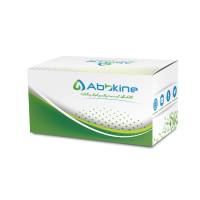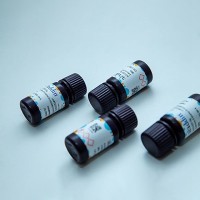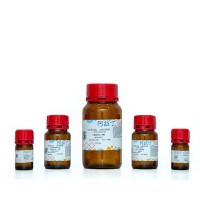双向凝胶荧光染色与成像
丁香园
3813
1. 前言
通过电泳分离蛋白是蛋白质组学研究中常用的方法,因为其分辨率较高,有强大的进行凝胶对比的图像分析软件,并且与质谱技术的蛋白定性具有兼容性 [ 1,2] 。由于以上多方面原因,蛋白染色步骤显得尤为重要。
1.1 可供凝胶染色的染料
通常来说,考马斯亮蓝(CCB ) 是应用最广泛的蛋白质染料。然而,它在蛋白检测方面灵敏度较低(蛋白质的检测量为数十纳克) [ 3,4] 。它和蛋白质是通过范德华力和亲水相互作用来结合的。这种非共价结合方式使得染料能与基质辅助激光解吸电离飞行时间质谱(MALDI- TOFMS ) 兼容 [ 5 ] 。长期以来,CCB —直被认为是大规模蛋白质分析中一种方便的染料。
另一种常用的蛋白质染料是硝酸银(SN ) ,它具有较髙的检测灵敏度(蛋白质的检测量最低可至 1 ng ) ,但会干扰质谱技术进行的蛋白质分析。有两种银染方法被用来观察凝胶中的蛋白——酸性硝酸银和碱性铵银,两者在蛋白的结合特异性、灵敏度、成本和毒性方面有所不同 [ 6,7] 。银可以通过形成银盐的方式结合在蛋白质的谷氨酸和天冬氨酸残基的酸性基团上,或者形成复合体结合在组氨酸、半胱氨酸、甲硫氨酸或赖氨酸残基的亲核基团上 [6] 。由于涉及复杂的化学过程,目前有许多改进的方案,这些方法可降低背景和增加灵敏度 [ 8~10]。近年来,新的技术更关注如何改进银染方法和质谱技术的兼容性 [ 11~16] 。由于银离子对蛋白具有氧化作用和影响凝胶感化剂预处理 [6],造成对氨基酸不可逆修饰从而影响了肽质指纹图谱分析或其他的质谱分析。大多数的改进方法包括去掉交联剂和增敏剂如戊二醛、甲醛 [5,11,14~16] ,以及改进酶消化前的脱色方法 [13] 。本章描述了一种酸性方法,它具有较好的灵敏度、清晰的背景 [ 15 ] ,而且和质谱兼容。
在过去的几年中,一些荧光染料被用来凝胶染色,它们被证明具有较高的灵敏度而且兼容质谱鉴定。这些染料包括商业化的如 Sypros 系列染料,也包括以钌红为主要成分的染料 [ 17~21 ] 。Sypr Ruby ( SR ) 具有与 CCB 相似的一些特征,它是一种发光的钌复合材料,可与蛋白非共价作用。由于染色过程中对氨基酸的修饰是可逆的,所以它与质谱可能会有较好的兼容性[ 17,19] 。另外,尽管 SR 染色饱和度低,但它具有更宽的 [22] 线性范围;与 SN 相比,灵敏度更高,所以这种染料在大规模蛋白质组分析方面,应用性更强 [23] 。然而这种染料需要荧光扫描仪来扫描染色结果,从而增加了这种染色方法的成本,所以即使有钌复本,这一缺点也限制了其应用。
最近又有新的染料分子被发现。Deep Purple ( DP ) 起初被命名为 “ 亮得快” ,是一种灵敏度较高的突光染料 [ 25 ] ,它是基于从真菌中提取出来的一种天然复合物,现已有商业供应(Amersham Biosciences) 。这种突光聚酮化合物可以与蛋白结合,可能与赖氨酸残基作用从而发出荧光 [26] 。它比 SR 的灵敏度更高而且可与MALDI-TOF 质谱技术兼容 [ 25 ] 。然而它也表现出染色饱和性 [23] 。
荧光素衍生物是另一种可选择的荧光染料。具有不同碳氢化合物链的 3 种荧光素衍生物的检测表明可作为凝胶染色的荧光染料 [27] 。在本章中,我们展示了 C16 荧光素的染色过程,它表现出较高的灵敏度和清晰的背景,而且没有饱和倾向 [23] 。
1.2 蛋白质组分析中选择染料的重要性
运用双相凝胶电泳技术进行的大规模蛋白质组学已得到广泛应用,比如遗传多样性的鉴定 [28,29] 、发育过程的分析 [ 30,31] 、生物和非生物胁迫的研究 [32,33] 等方面。在蛋白质组分析中染料的选择至关重要,其中操作时间、化学产品的成本、所需仪器、染料的敏感度以及其是否能与质谱兼容都是选择染料的依据。在近期工作中,我们比较了 5 种染料的染色方法以帮助实验者在通过图像分析的双相凝胶电泳的大规模比较中选择合适的蛋白质染料 [23] 。结果表明,当蛋白质上样量相同时,用不同的染料可检测到的蛋白质点数量相差近 3 倍,依次是 SR > SN≈DP > C16-F > CCB。这与染料的敏感度不同有关,高敏感性的染料甚至可检出低丰度的蛋白质。不同染料染色结果的可重复性也有差异,从髙到低依次为 SR > C16-F > DP> SN > CCB。
本章详细描述了 5 种染料的凝胶染色方案。为帮助读者选择合适的染色方案,我们展示了从拟南芥悬浮细胞中提取的 100 μg 蛋白质样品的凝胶染色结果。
2. 材料
所有溶液的配制和清洗都只能用超纯水。
2.1 蛋白提取和双相电泳
( 1 ) 提取液:90% 冷冻( -20°C ) 丙酮(V/V ) ,10% 三氯乙酸(TCA ) ( V/V ),0.07% 2-巯基乙醇(V/V ) 。
( 2 ) 洗涤液:90% 冷冻( -20°C ) 丙酮(V/V ),0.07% 2-巯基乙醇(V/V ) 。
( 3 ) 溶解液:9 mol/L 尿素,4% 3- [ ( 3-胆酰氨基丙基)二甲氨基 ] 丙磺酸盐 ( m/V ),0.05% Triton X-100 ( V/V ),65 mmol/L 二硫苏糖醇(DTT ) 。
( 4 ) 第一向电泳缓冲液:0.5% 固相 pH 梯度(IPG ) 缓冲液 4~7 ( V/V ) ,0.002% ( m/V ) 溴酚蓝。
( 5 ) 还原溶液:50 mmol/L Tris-HCl ( pH 8.8),6 mol/L 尿素,30% ( V/V ) 甘油,2%(m/V)十二烷基硫酸钠(SDS) ,130 mmol/L 二硫苏糖醇(DTT) ( 见注释 1)。
( 6 ) 烷基化溶液:50 mmol/L Tris-HCl ( pH 8.8 ) ,6 mol/L 尿素,30% ( V/V)甘油,2% ( m/V ) 十二烷基硫酸钠(SDS),130 mmol/L 碘乙酰胺(见注释 1)。
( 7 ) 琼脂糖溶液:0.6% ( m/V ) 低熔点琼脂糖电泳缓冲液(见 14. 3.1 节 9) ,含微量溴酚蓝。
( 8 ) 丙烯酰胺凝胶溶液:11% 丙烯酰胺,0.375 mol/L Tris-HCl ( pH 8.8),0.1% 十二烷基硫酸钠(SDS) ,0.05% 过硫酸铵 0.0003% 四甲基乙二铵(TEMED ) ( 见注释1 ) 。
( 9 ) 电泳缓冲液:25 mmol/L Tris,192 mmol/L 甘氨酸,0.1% 十二烷基硫酸钠 ( SDS) ( m/V ) ( 见注释 1)。
2.2 胶体考马斯亮蓝(CCB) 凝胶染色(见注释 2)
( 1 ) 固定液:50% ( V/V ) 乙醇,2% ( V/V ) 磷酸。
( 2 ) 培育液:34% ( V/V ) 甲醇,2% ( V/V ) 磷酸,17% ( m/V ) 过硫酸铵。
先将过硫酸铵和磷酸加入水中混合(300 ml 总体积溶液中含 180 ml 水),然后边搅拌边将甲醇慢慢地加入到混合溶液中。
( 3 ) 染色液:34% (V/V ) 甲醇,2%(V/V ) 磷酸,17% ( m/V ) 过硫酸铵,0.05% ( m/V) 考马斯亮蓝 G-250。先将过硫酸铵、磷酸和考马斯亮蓝 G-250 加入水中混合(300 ml 总体积溶液中含 180 ml 水) ,然后边搅拌边将甲醇慢慢地加入到混合溶液中。
2.3 硝酸银(SN) 凝胶染色(见注释3)
( 1 ) 固定液:50%(V/V ) 甲醇,12% ( V/V );乙酸,0.05%(V/V) 甲醛。
( 2 ) 洗涤液:35% ( V/V ) 乙醇。
( 3 ) 敏化液:0.02% ( m/V ) 硫酸钠。
( 4 ) 染色液:0.2% ( m/V ) 硝酸银,0.076% ( V/V ) 甲醛。
( 5 ) 显色液:6% (m/V ) 碳酸钠,0.05% (V/V ) 甲醛,0.0004% (m/V ) 硫酸钠。
( 6 ) 终止液:50%(V/V ) 甲醇,12%(V/V) 乙酸。
( 7 ) 贮存液:1% ( V/V ) 乙酸。
2.4 SR 凝胶染色(见注释4)
( 1 ) 固定液:10% ( V/V ) 甲醇,7.5% ( V/V)乙酸。
( 2 ) 染色液:商家提供的 200X Deep Purple 溶液用水稀释 200 倍。
( 3 ) 洗涤液 1:0.1% ( V/V ) 氢氧化铵。
( 4 ) 洗涤液 2:0.75% ( V/V ) 乙酸。
2.5 C16-F 凝胶染色(见注释 6)
( 1 ) 固定和染色液:30% ( V/V ) 乙醇,7.5%(V/V ) 乙酸,5-十六碳酰基荧光素。
( 2 ) 洗涤液:7.5% 乙酸。
2.6 仪器
( 1 ) 双向凝胶电泳:标准的双向凝胶电泳仪器,使用固相 pH 梯度胶条进行第一向电泳 [ 此处所示的凝胶类似 IPG-Phor 和 Dalt 体系 [ Amersham Bioscience,Buckinghamshire,UK )] 。
( 2 ) 图像获得:可见光扫描仪或密度计 [ 此处所示的凝胶类似 GS-710 ( Bio- Rad,Hercules,CA )] ,多波长荧光扫描仪 [ 此处所示的凝胶类似 FLA-5000 ( Fuji PhotoFilm Company,Tokyo,Japan )]。
4. 注释
( 1 ) 建议使用 Deep Purple 和高质量 SDS 进行染色的凝胶,避免非特异性染色和背景(比如 USB 的产品,Cleveland,USA)
( 2 ) 有不同来源的 CCB 可供使用,在本实验中,使用了考马斯亮蓝 G-250 ( Ref 161-0406,Biorad,Hercules,CA,USA)。
( 3 ) 有不同来源的 SN 可供使用,在本实验中,使用了硝酸银(产品批号 S-0139,Sigma-Aldrich,St. Louis, MO)。
( 4 ) Sypro Ruby 由不同的供货商提供,在本实验中,使用了 SR ( 产品批号 1703125, Bio- Rad)。
( 5 ) Deep Purple ( 产品批号 RPN 6305,Amersham Biosciences, Buckinghamshire,UK ) 。
( 6 ) 5-十六碳酰基荧光素(产品批号 H-110,Molecular Probes, Eugene, OR) 。
( 7 ) 蛋白通常在 -20°C 沉淀 30 min 即可。建议延长贮存时间 (-20°C 过夜)以改善沉淀效果,尤其是体积小和 (或)亲水蛋白分子。
( 8 ) 无上清液的管子可贮存在 -20°C。
( 9 ) 可通过延长搅拌时间(过夜)和 ( 或)使用水浴锅超声波进行短时间的超声处理来增加蛋白溶解度。
( 10 ) 经过 2 h 的电洗脱(每块胶 15 mA) ,蛋白质从胶条进入到第二向凝胶中,此时可将电流增加到 30 mA 从而加快蛋白的迁移。
( 11 ) 第二向电泳完成后(当溴酚蓝前端到达凝胶的底端时),必须快速将凝胶转移到固定液中以限制蛋白质被动扩散。
( 12 ) 为限制对大型凝胶的操作和避免凝胶破裂,建议在连续的操作步骤中更换溶液时使用真空泵吸出溶液。
( 13 ) 配制 CCB 培育液和染色液时,应小心地将甲醇溶液(染色液中为考马斯亮蓝)慢慢加入到搅拌中的过硫酸铵溶液中。将甲醇溶液和过硫酸铵溶液混合时,过硫酸铵会沉淀,形成致密的结块。为避免这种情况发生,一定要小心的将甲醇溶液加入到过硫酸铵溶液中(将过硫酸铵溶解在 180 ml 水中,定容到 300 ml 终体积),切记不要将过硫酸铵溶液加入到甲醇溶液中。在混合过程中,会产生白色的过硫酸铵沉淀,只需加入少量的水使其复溶。
( 14 ) 为避免考马斯亮蓝结晶,使用前 2 h 配制染色液。考马斯亮蓝需要先在甲醇中溶解 1h。甲醇和考马斯亮蓝溶液需与过硫酸铵混合至少 1 h 以获得均匀的蓝色溶液。
( 15 ) 敏化是凝胶染色中一个快速而且重要的步骤,它允许银对蛋白质的进一步固定。这一过程要在无乙醇的溶液中完成,因为之前的过程中含有 35% 的乙醇,凝胶容易漂浮。为避免这个问题,在敏化过程中可增加搅拌速度以及将敏化溶液体积增加 2 倍。
( 16 ) 可在 5~10 min 内方便获得显影。由于将显色液换成终止液时此化学反应不会立即停止,需要预期染色终止时间有以限制蛋白质点的过度着色。
( 17 ) 在使用荧光染料时,所有的染色步骤都必须在黑暗中进行。可使用铝铂纸来包裹染色器皿。
( 18 ) 对 C16 荧光素染色来说,必须使用玻璃器皿以避免塑料器皿吸附染料。
参考文献
1. Van Wijk, K. J. (2001) Challenges and prospects of plant proteomics. PlantPhysiol. 12 6, 501-508.
2. Patton, W. F. (2002) Detection technologies in proteome analysis. J. Chromatogr.5. 771, 3—31.
3. Neuhoff, V., Arold, N., Taube, D., and Ehrhardt, W. (1988) Improved staining ofproteins in polyacrylamide gels including isoelectric focusing gels with clear background at nanogram sensitivity using Coomassie Brilliant Blue G-250and R-250.Electrophoresis 9, 255-262.
4. Neuhoff, V., Stamm, R., Pardowitz, L, Arold, N., Ehrhardt, W., and Taube, D.(1990) Essential problems in quantification of proteins following colloidal staining with Coomassie brilliant blue dyes in polyacrylamide gels, and their solution Electrophoresis 11, 101-117.
5. Scheler, C., Lamer, S., Pan, Z., Li, X. P., Salnikow, J., and Jungblut, P. (1998)Peptide mass fingerprint sequence coverage from differently stained proteins ontwo-dimensional electrophoresis patterns by matrix assisted laser desorption/ion-ization-mass spectrometry (MALDI-MS). Electrophoresis 19, 918-927.
6. Rabilloud, T. (1990) Mechanisms of protein silver staining in polyacrylamide gels:a 10-year synthesis. Electrophoresis 11, 785-794.
7. Patton, W. F. (2000) A thousand points of light: the application of fluorescencedetection technologies to two-dimensional gel electrophoresis and proteomics.Electrophoresis 21, 1123-1144.
8 . Rabilloud, T., Carpentier, G., and Tarroux, P. (1988) Improvement and simplification of low-background silver staining of proteins by using sodium dithionite.Electrophoresis 9, 288-291.
9. Swain, M. and Ross, N. W. (1995) A silver stain protocol for proteins yieldinghigh resolution and transparent background in sodium dodecyl sulphate-polyacrylamide gels. Electrophoresis 16, 948-951.
10 . Rabilloud, T. (1992) A comparison between low background silver diammine andsilver nitrate protein stains. Electrophoresis 13, 429-439.
11. Shevchenko, A., Wilm, M., Vorm, 0 ., and Mann, M. (1996) Mass spectrometric sequencing of proteins silver-stained polyacrylamide gels. Anal Chem. 68, 850-858.
1 2 . Larsson, T., Norbeck, J., Karlsson, H., Karlsson, K. A., and Blomberg, A. (1997)Identification of two-dimensional gel electrophoresis resolved yeast proteins bymatrix-assisted laser desorption ionization mass spectrometry. Electrophoresis 1 8 ,418-423.
13. Gharahdaghi, F., Weinberg, C. R., Meagher, D. A., Imai, B. S., and Mische, S. M.(1999) Mass spectrometric identification of proteins from silver-stained polyacrylamide gel: a method for the removal of silver ions to enhance sensitivity. Electrophoresis 20, 601-605.
14. Yan, J. X., Wait, R., Berkelman, T., et al. (2000) A modified silver staining protocol for visualization of proteins compatible with matrix-assisted laser desorption/ionization and electrospray ionization-mass spectrometry. Electrophoresis 21,3666-3672.
15. Mortz, E., Krogh, T.N., Vorum, H., and Gorg, A. (2001) Improved silver stainingprotocols for high sensitivity protein identification using matrix-assisted laser des-orption/ionization-time of flight analysis. Proteomics 1, 1359-1363.
16. Richert, S., Luche, S., Chevallet, M., Van Dorsselaer, A., Leize-Wagner, E., andRabilloud, T. (2004) About the mechanism of interference of silver staining withpeptide mass spectrometry. Proteomics 4 ,909-916.
17. Berggren, K., Steinberg, T. H., Lauber, W. M., et al. (1999) A luminescent ruthenium complex for ultrasensitive detection of proteins immobilized on membranesupports. Anal. Biochem. 276, 129—143.
18 . Berggren, K., Chemokalskaya, E., Steinberg, T. H., et al. (2000) Background-free,high sensitivity staining of proteins in one- and two-dimensional sodium dodecylsulphate-polyacrylamide gels using a luminescent ruthenium complex. Electrophoresis 1 2 , 2509-2521.
19 . Berggren, K. N., Schulenberg, B., Lopez, M. F., et al. (2002) An improved formulation of S YPRO Ruby protein gel stain: comparison with the original formulationand with a ruthenium II tris (bathophenanthroline disulfonate) formulation.Proteomics 2, 486-498.
20. Steinberg, T. H., Chernokalskaya, E., Berggren, K., et al. (2000). Ultrasensitivefluorescence protein detection in isoelectric focusing gels using a ruthenium metalchelate stain. Electrophoresis 21,486-496.
21. Rabilloud, T., Strub, J. M., Luche, S., van Dorsselaer, A., and Lunardi, J. (2001) Acomparison between Sypro Ruby and ruthenium II tris (bathophenanthrolinedisulfonate) as fluorescent stains for protein detection in gels. Proteomics 1 ,699-704.
22. Lopez, M. F, Berggren, K, Chernokalskaya, E, Lazarev, A, Robinson, M, andPatton, W. F. (2000) A comparison of silver stain and SYPRO Ruby Protein GelStain with respect to protein detection in two-dimensional gels and identificationby peptide mass profiling. Electrophoresis 21, 3673-3683.
23. Chevalier, F., Rofidal, V., Vanova, P., Bergoin, A., and Rossignol, M. (2004)Proteomic capacity of recent fluorescent dyes for protein staining. Phytochemistry 6 5 ,1499-1506.
24. Lamanda, A., Zahn, A., Roder, D., and Langen, H. (2004) Improved ruthenium IItris (bathophenantroline disulfonate) staining and destaining protocol for a bettersignal-to-background ratio and improved baseline resolution. Proteomics 4,599-608.
25. Mackintosh, J. A., Choi, H. Y., Bae, S. H., et al. (2003) A fluorescent naturalproduct for ultra sensitive detection of proteins in one-dimensional and two-dimensional gel electrophoresis. Proteomics 3 , 2273-2288.
26. Bell, P. J. and Karuso, P. (2003) Epicocconone, a novel fluorescent compoundfrom the fungus Epicoccum nigrum. J. Am. Chem. Soc. 1 2 5, 9304-9305.
27. Kang, C., Kim, H. J., Kang, D., Jung, D. Y., and Suh, M. (2003) Highly sensitiveand simple fluorescence staining of proteins in sodium dodecyl sulphate-polyacry-lamide-based gels by using hydrophobic tail-mediated enhancement of fluoresceinluminescence. Electrophoresis 24, 3297-3304.
28. Thiellement, H., Bahrman, N., Damerval, C., et al. (1999) Proteomics for geneticand physiological studies in plants. Electrophoresis 20, 2013-2026.
29. Marques, K., Sarazin, B., Chane-Favre, L., Zivy, M., and Thiellement, H. (2001)Comparative proteomics to establish genetic relationships in the Brassicaceae family. Proteomics 1, 1457-1462.
30. Santoni, V., Delarue, M., Caboche, M., and Bellini, C. (1997) A comparison of two-dimensional electrophoresis data with phenotypical traits in Arabidopsisleadsto the identification of a mutant (cril) that accumulates cytokinins. Planta 202,62-69.
31. Gallardo, K., Job, C., Groot, S. P., et al. (2002) Proteomics of Arabidopsisseed.Plant Physiol.129, 823— 837.
32. Costa, P., Bahrman, N., Frigerio, J. M., Kremer, A., and Plomion, C. (1998) Water-deficit-responsive proteins in maritime pine. Plant Mol. Biol.38, 587-596.
33. Bestel-Corre, G., Dumas-Gaudot, E., Poinsot, V., et al. (2002) Proteome analysisand identification of symbiosis-related proteins from Medicago truncatulaGaertn.by two-dimensional electrophoresis and mass spectrometry. Electrophoresis 23,122-137.
34. Bradford, M. M. (1976) A rapid and sensitive method for the quantitation ofmicrogram quantities of protein utilizing the principle of protein-dye binding. Anal.Biochem.72, 248-254.
通过电泳分离蛋白是蛋白质组学研究中常用的方法,因为其分辨率较高,有强大的进行凝胶对比的图像分析软件,并且与质谱技术的蛋白定性具有兼容性 [ 1,2] 。由于以上多方面原因,蛋白染色步骤显得尤为重要。
1.1 可供凝胶染色的染料
通常来说,考马斯亮蓝(CCB ) 是应用最广泛的蛋白质染料。然而,它在蛋白检测方面灵敏度较低(蛋白质的检测量为数十纳克) [ 3,4] 。它和蛋白质是通过范德华力和亲水相互作用来结合的。这种非共价结合方式使得染料能与基质辅助激光解吸电离飞行时间质谱(MALDI- TOFMS ) 兼容 [ 5 ] 。长期以来,CCB —直被认为是大规模蛋白质分析中一种方便的染料。
另一种常用的蛋白质染料是硝酸银(SN ) ,它具有较髙的检测灵敏度(蛋白质的检测量最低可至 1 ng ) ,但会干扰质谱技术进行的蛋白质分析。有两种银染方法被用来观察凝胶中的蛋白——酸性硝酸银和碱性铵银,两者在蛋白的结合特异性、灵敏度、成本和毒性方面有所不同 [ 6,7] 。银可以通过形成银盐的方式结合在蛋白质的谷氨酸和天冬氨酸残基的酸性基团上,或者形成复合体结合在组氨酸、半胱氨酸、甲硫氨酸或赖氨酸残基的亲核基团上 [6] 。由于涉及复杂的化学过程,目前有许多改进的方案,这些方法可降低背景和增加灵敏度 [ 8~10]。近年来,新的技术更关注如何改进银染方法和质谱技术的兼容性 [ 11~16] 。由于银离子对蛋白具有氧化作用和影响凝胶感化剂预处理 [6],造成对氨基酸不可逆修饰从而影响了肽质指纹图谱分析或其他的质谱分析。大多数的改进方法包括去掉交联剂和增敏剂如戊二醛、甲醛 [5,11,14~16] ,以及改进酶消化前的脱色方法 [13] 。本章描述了一种酸性方法,它具有较好的灵敏度、清晰的背景 [ 15 ] ,而且和质谱兼容。
在过去的几年中,一些荧光染料被用来凝胶染色,它们被证明具有较高的灵敏度而且兼容质谱鉴定。这些染料包括商业化的如 Sypros 系列染料,也包括以钌红为主要成分的染料 [ 17~21 ] 。Sypr Ruby ( SR ) 具有与 CCB 相似的一些特征,它是一种发光的钌复合材料,可与蛋白非共价作用。由于染色过程中对氨基酸的修饰是可逆的,所以它与质谱可能会有较好的兼容性[ 17,19] 。另外,尽管 SR 染色饱和度低,但它具有更宽的 [22] 线性范围;与 SN 相比,灵敏度更高,所以这种染料在大规模蛋白质组分析方面,应用性更强 [23] 。然而这种染料需要荧光扫描仪来扫描染色结果,从而增加了这种染色方法的成本,所以即使有钌复本,这一缺点也限制了其应用。
最近又有新的染料分子被发现。Deep Purple ( DP ) 起初被命名为 “ 亮得快” ,是一种灵敏度较高的突光染料 [ 25 ] ,它是基于从真菌中提取出来的一种天然复合物,现已有商业供应(Amersham Biosciences) 。这种突光聚酮化合物可以与蛋白结合,可能与赖氨酸残基作用从而发出荧光 [26] 。它比 SR 的灵敏度更高而且可与MALDI-TOF 质谱技术兼容 [ 25 ] 。然而它也表现出染色饱和性 [23] 。
荧光素衍生物是另一种可选择的荧光染料。具有不同碳氢化合物链的 3 种荧光素衍生物的检测表明可作为凝胶染色的荧光染料 [27] 。在本章中,我们展示了 C16 荧光素的染色过程,它表现出较高的灵敏度和清晰的背景,而且没有饱和倾向 [23] 。
1.2 蛋白质组分析中选择染料的重要性
运用双相凝胶电泳技术进行的大规模蛋白质组学已得到广泛应用,比如遗传多样性的鉴定 [28,29] 、发育过程的分析 [ 30,31] 、生物和非生物胁迫的研究 [32,33] 等方面。在蛋白质组分析中染料的选择至关重要,其中操作时间、化学产品的成本、所需仪器、染料的敏感度以及其是否能与质谱兼容都是选择染料的依据。在近期工作中,我们比较了 5 种染料的染色方法以帮助实验者在通过图像分析的双相凝胶电泳的大规模比较中选择合适的蛋白质染料 [23] 。结果表明,当蛋白质上样量相同时,用不同的染料可检测到的蛋白质点数量相差近 3 倍,依次是 SR > SN≈DP > C16-F > CCB。这与染料的敏感度不同有关,高敏感性的染料甚至可检出低丰度的蛋白质。不同染料染色结果的可重复性也有差异,从髙到低依次为 SR > C16-F > DP> SN > CCB。
本章详细描述了 5 种染料的凝胶染色方案。为帮助读者选择合适的染色方案,我们展示了从拟南芥悬浮细胞中提取的 100 μg 蛋白质样品的凝胶染色结果。
2. 材料
所有溶液的配制和清洗都只能用超纯水。
2.1 蛋白提取和双相电泳
( 1 ) 提取液:90% 冷冻( -20°C ) 丙酮(V/V ) ,10% 三氯乙酸(TCA ) ( V/V ),0.07% 2-巯基乙醇(V/V ) 。
( 2 ) 洗涤液:90% 冷冻( -20°C ) 丙酮(V/V ),0.07% 2-巯基乙醇(V/V ) 。
( 3 ) 溶解液:9 mol/L 尿素,4% 3- [ ( 3-胆酰氨基丙基)二甲氨基 ] 丙磺酸盐 ( m/V ),0.05% Triton X-100 ( V/V ),65 mmol/L 二硫苏糖醇(DTT ) 。
( 4 ) 第一向电泳缓冲液:0.5% 固相 pH 梯度(IPG ) 缓冲液 4~7 ( V/V ) ,0.002% ( m/V ) 溴酚蓝。
( 5 ) 还原溶液:50 mmol/L Tris-HCl ( pH 8.8),6 mol/L 尿素,30% ( V/V ) 甘油,2%(m/V)十二烷基硫酸钠(SDS) ,130 mmol/L 二硫苏糖醇(DTT) ( 见注释 1)。
( 6 ) 烷基化溶液:50 mmol/L Tris-HCl ( pH 8.8 ) ,6 mol/L 尿素,30% ( V/V)甘油,2% ( m/V ) 十二烷基硫酸钠(SDS),130 mmol/L 碘乙酰胺(见注释 1)。
( 7 ) 琼脂糖溶液:0.6% ( m/V ) 低熔点琼脂糖电泳缓冲液(见 14. 3.1 节 9) ,含微量溴酚蓝。
( 8 ) 丙烯酰胺凝胶溶液:11% 丙烯酰胺,0.375 mol/L Tris-HCl ( pH 8.8),0.1% 十二烷基硫酸钠(SDS) ,0.05% 过硫酸铵 0.0003% 四甲基乙二铵(TEMED ) ( 见注释1 ) 。
( 9 ) 电泳缓冲液:25 mmol/L Tris,192 mmol/L 甘氨酸,0.1% 十二烷基硫酸钠 ( SDS) ( m/V ) ( 见注释 1)。
2.2 胶体考马斯亮蓝(CCB) 凝胶染色(见注释 2)
( 1 ) 固定液:50% ( V/V ) 乙醇,2% ( V/V ) 磷酸。
( 2 ) 培育液:34% ( V/V ) 甲醇,2% ( V/V ) 磷酸,17% ( m/V ) 过硫酸铵。
先将过硫酸铵和磷酸加入水中混合(300 ml 总体积溶液中含 180 ml 水),然后边搅拌边将甲醇慢慢地加入到混合溶液中。
( 3 ) 染色液:34% (V/V ) 甲醇,2%(V/V ) 磷酸,17% ( m/V ) 过硫酸铵,0.05% ( m/V) 考马斯亮蓝 G-250。先将过硫酸铵、磷酸和考马斯亮蓝 G-250 加入水中混合(300 ml 总体积溶液中含 180 ml 水) ,然后边搅拌边将甲醇慢慢地加入到混合溶液中。
2.3 硝酸银(SN) 凝胶染色(见注释3)
( 1 ) 固定液:50%(V/V ) 甲醇,12% ( V/V );乙酸,0.05%(V/V) 甲醛。
( 2 ) 洗涤液:35% ( V/V ) 乙醇。
( 3 ) 敏化液:0.02% ( m/V ) 硫酸钠。
( 4 ) 染色液:0.2% ( m/V ) 硝酸银,0.076% ( V/V ) 甲醛。
( 5 ) 显色液:6% (m/V ) 碳酸钠,0.05% (V/V ) 甲醛,0.0004% (m/V ) 硫酸钠。
( 6 ) 终止液:50%(V/V ) 甲醇,12%(V/V) 乙酸。
( 7 ) 贮存液:1% ( V/V ) 乙酸。
2.4 SR 凝胶染色(见注释4)
( 1 ) 固定液:10% ( V/V ) 甲醇,7.5% ( V/V)乙酸。
( 2 ) 染色液:商家提供的 200X Deep Purple 溶液用水稀释 200 倍。
( 3 ) 洗涤液 1:0.1% ( V/V ) 氢氧化铵。
( 4 ) 洗涤液 2:0.75% ( V/V ) 乙酸。
2.5 C16-F 凝胶染色(见注释 6)
( 1 ) 固定和染色液:30% ( V/V ) 乙醇,7.5%(V/V ) 乙酸,5-十六碳酰基荧光素。
( 2 ) 洗涤液:7.5% 乙酸。
2.6 仪器
( 1 ) 双向凝胶电泳:标准的双向凝胶电泳仪器,使用固相 pH 梯度胶条进行第一向电泳 [ 此处所示的凝胶类似 IPG-Phor 和 Dalt 体系 [ Amersham Bioscience,Buckinghamshire,UK )] 。
( 2 ) 图像获得:可见光扫描仪或密度计 [ 此处所示的凝胶类似 GS-710 ( Bio- Rad,Hercules,CA )] ,多波长荧光扫描仪 [ 此处所示的凝胶类似 FLA-5000 ( Fuji PhotoFilm Company,Tokyo,Japan )]。
4. 注释
( 1 ) 建议使用 Deep Purple 和高质量 SDS 进行染色的凝胶,避免非特异性染色和背景(比如 USB 的产品,Cleveland,USA)
( 2 ) 有不同来源的 CCB 可供使用,在本实验中,使用了考马斯亮蓝 G-250 ( Ref 161-0406,Biorad,Hercules,CA,USA)。
( 3 ) 有不同来源的 SN 可供使用,在本实验中,使用了硝酸银(产品批号 S-0139,Sigma-Aldrich,St. Louis, MO)。
( 4 ) Sypro Ruby 由不同的供货商提供,在本实验中,使用了 SR ( 产品批号 1703125, Bio- Rad)。
( 5 ) Deep Purple ( 产品批号 RPN 6305,Amersham Biosciences, Buckinghamshire,UK ) 。
( 6 ) 5-十六碳酰基荧光素(产品批号 H-110,Molecular Probes, Eugene, OR) 。
( 7 ) 蛋白通常在 -20°C 沉淀 30 min 即可。建议延长贮存时间 (-20°C 过夜)以改善沉淀效果,尤其是体积小和 (或)亲水蛋白分子。
( 8 ) 无上清液的管子可贮存在 -20°C。
( 9 ) 可通过延长搅拌时间(过夜)和 ( 或)使用水浴锅超声波进行短时间的超声处理来增加蛋白溶解度。
( 10 ) 经过 2 h 的电洗脱(每块胶 15 mA) ,蛋白质从胶条进入到第二向凝胶中,此时可将电流增加到 30 mA 从而加快蛋白的迁移。
( 11 ) 第二向电泳完成后(当溴酚蓝前端到达凝胶的底端时),必须快速将凝胶转移到固定液中以限制蛋白质被动扩散。
( 12 ) 为限制对大型凝胶的操作和避免凝胶破裂,建议在连续的操作步骤中更换溶液时使用真空泵吸出溶液。
( 13 ) 配制 CCB 培育液和染色液时,应小心地将甲醇溶液(染色液中为考马斯亮蓝)慢慢加入到搅拌中的过硫酸铵溶液中。将甲醇溶液和过硫酸铵溶液混合时,过硫酸铵会沉淀,形成致密的结块。为避免这种情况发生,一定要小心的将甲醇溶液加入到过硫酸铵溶液中(将过硫酸铵溶解在 180 ml 水中,定容到 300 ml 终体积),切记不要将过硫酸铵溶液加入到甲醇溶液中。在混合过程中,会产生白色的过硫酸铵沉淀,只需加入少量的水使其复溶。
( 14 ) 为避免考马斯亮蓝结晶,使用前 2 h 配制染色液。考马斯亮蓝需要先在甲醇中溶解 1h。甲醇和考马斯亮蓝溶液需与过硫酸铵混合至少 1 h 以获得均匀的蓝色溶液。
( 15 ) 敏化是凝胶染色中一个快速而且重要的步骤,它允许银对蛋白质的进一步固定。这一过程要在无乙醇的溶液中完成,因为之前的过程中含有 35% 的乙醇,凝胶容易漂浮。为避免这个问题,在敏化过程中可增加搅拌速度以及将敏化溶液体积增加 2 倍。
( 16 ) 可在 5~10 min 内方便获得显影。由于将显色液换成终止液时此化学反应不会立即停止,需要预期染色终止时间有以限制蛋白质点的过度着色。
( 17 ) 在使用荧光染料时,所有的染色步骤都必须在黑暗中进行。可使用铝铂纸来包裹染色器皿。
( 18 ) 对 C16 荧光素染色来说,必须使用玻璃器皿以避免塑料器皿吸附染料。
参考文献
1. Van Wijk, K. J. (2001) Challenges and prospects of plant proteomics. PlantPhysiol. 12 6, 501-508.
2. Patton, W. F. (2002) Detection technologies in proteome analysis. J. Chromatogr.5. 771, 3—31.
3. Neuhoff, V., Arold, N., Taube, D., and Ehrhardt, W. (1988) Improved staining ofproteins in polyacrylamide gels including isoelectric focusing gels with clear background at nanogram sensitivity using Coomassie Brilliant Blue G-250and R-250.Electrophoresis 9, 255-262.
4. Neuhoff, V., Stamm, R., Pardowitz, L, Arold, N., Ehrhardt, W., and Taube, D.(1990) Essential problems in quantification of proteins following colloidal staining with Coomassie brilliant blue dyes in polyacrylamide gels, and their solution Electrophoresis 11, 101-117.
5. Scheler, C., Lamer, S., Pan, Z., Li, X. P., Salnikow, J., and Jungblut, P. (1998)Peptide mass fingerprint sequence coverage from differently stained proteins ontwo-dimensional electrophoresis patterns by matrix assisted laser desorption/ion-ization-mass spectrometry (MALDI-MS). Electrophoresis 19, 918-927.
6. Rabilloud, T. (1990) Mechanisms of protein silver staining in polyacrylamide gels:a 10-year synthesis. Electrophoresis 11, 785-794.
7. Patton, W. F. (2000) A thousand points of light: the application of fluorescencedetection technologies to two-dimensional gel electrophoresis and proteomics.Electrophoresis 21, 1123-1144.
8 . Rabilloud, T., Carpentier, G., and Tarroux, P. (1988) Improvement and simplification of low-background silver staining of proteins by using sodium dithionite.Electrophoresis 9, 288-291.
9. Swain, M. and Ross, N. W. (1995) A silver stain protocol for proteins yieldinghigh resolution and transparent background in sodium dodecyl sulphate-polyacrylamide gels. Electrophoresis 16, 948-951.
10 . Rabilloud, T. (1992) A comparison between low background silver diammine andsilver nitrate protein stains. Electrophoresis 13, 429-439.
11. Shevchenko, A., Wilm, M., Vorm, 0 ., and Mann, M. (1996) Mass spectrometric sequencing of proteins silver-stained polyacrylamide gels. Anal Chem. 68, 850-858.
1 2 . Larsson, T., Norbeck, J., Karlsson, H., Karlsson, K. A., and Blomberg, A. (1997)Identification of two-dimensional gel electrophoresis resolved yeast proteins bymatrix-assisted laser desorption ionization mass spectrometry. Electrophoresis 1 8 ,418-423.
13. Gharahdaghi, F., Weinberg, C. R., Meagher, D. A., Imai, B. S., and Mische, S. M.(1999) Mass spectrometric identification of proteins from silver-stained polyacrylamide gel: a method for the removal of silver ions to enhance sensitivity. Electrophoresis 20, 601-605.
14. Yan, J. X., Wait, R., Berkelman, T., et al. (2000) A modified silver staining protocol for visualization of proteins compatible with matrix-assisted laser desorption/ionization and electrospray ionization-mass spectrometry. Electrophoresis 21,3666-3672.
15. Mortz, E., Krogh, T.N., Vorum, H., and Gorg, A. (2001) Improved silver stainingprotocols for high sensitivity protein identification using matrix-assisted laser des-orption/ionization-time of flight analysis. Proteomics 1, 1359-1363.
16. Richert, S., Luche, S., Chevallet, M., Van Dorsselaer, A., Leize-Wagner, E., andRabilloud, T. (2004) About the mechanism of interference of silver staining withpeptide mass spectrometry. Proteomics 4 ,909-916.
17. Berggren, K., Steinberg, T. H., Lauber, W. M., et al. (1999) A luminescent ruthenium complex for ultrasensitive detection of proteins immobilized on membranesupports. Anal. Biochem. 276, 129—143.
18 . Berggren, K., Chemokalskaya, E., Steinberg, T. H., et al. (2000) Background-free,high sensitivity staining of proteins in one- and two-dimensional sodium dodecylsulphate-polyacrylamide gels using a luminescent ruthenium complex. Electrophoresis 1 2 , 2509-2521.
19 . Berggren, K. N., Schulenberg, B., Lopez, M. F., et al. (2002) An improved formulation of S YPRO Ruby protein gel stain: comparison with the original formulationand with a ruthenium II tris (bathophenanthroline disulfonate) formulation.Proteomics 2, 486-498.
20. Steinberg, T. H., Chernokalskaya, E., Berggren, K., et al. (2000). Ultrasensitivefluorescence protein detection in isoelectric focusing gels using a ruthenium metalchelate stain. Electrophoresis 21,486-496.
21. Rabilloud, T., Strub, J. M., Luche, S., van Dorsselaer, A., and Lunardi, J. (2001) Acomparison between Sypro Ruby and ruthenium II tris (bathophenanthrolinedisulfonate) as fluorescent stains for protein detection in gels. Proteomics 1 ,699-704.
22. Lopez, M. F, Berggren, K, Chernokalskaya, E, Lazarev, A, Robinson, M, andPatton, W. F. (2000) A comparison of silver stain and SYPRO Ruby Protein GelStain with respect to protein detection in two-dimensional gels and identificationby peptide mass profiling. Electrophoresis 21, 3673-3683.
23. Chevalier, F., Rofidal, V., Vanova, P., Bergoin, A., and Rossignol, M. (2004)Proteomic capacity of recent fluorescent dyes for protein staining. Phytochemistry 6 5 ,1499-1506.
24. Lamanda, A., Zahn, A., Roder, D., and Langen, H. (2004) Improved ruthenium IItris (bathophenantroline disulfonate) staining and destaining protocol for a bettersignal-to-background ratio and improved baseline resolution. Proteomics 4,599-608.
25. Mackintosh, J. A., Choi, H. Y., Bae, S. H., et al. (2003) A fluorescent naturalproduct for ultra sensitive detection of proteins in one-dimensional and two-dimensional gel electrophoresis. Proteomics 3 , 2273-2288.
26. Bell, P. J. and Karuso, P. (2003) Epicocconone, a novel fluorescent compoundfrom the fungus Epicoccum nigrum. J. Am. Chem. Soc. 1 2 5, 9304-9305.
27. Kang, C., Kim, H. J., Kang, D., Jung, D. Y., and Suh, M. (2003) Highly sensitiveand simple fluorescence staining of proteins in sodium dodecyl sulphate-polyacry-lamide-based gels by using hydrophobic tail-mediated enhancement of fluoresceinluminescence. Electrophoresis 24, 3297-3304.
28. Thiellement, H., Bahrman, N., Damerval, C., et al. (1999) Proteomics for geneticand physiological studies in plants. Electrophoresis 20, 2013-2026.
29. Marques, K., Sarazin, B., Chane-Favre, L., Zivy, M., and Thiellement, H. (2001)Comparative proteomics to establish genetic relationships in the Brassicaceae family. Proteomics 1, 1457-1462.
30. Santoni, V., Delarue, M., Caboche, M., and Bellini, C. (1997) A comparison of two-dimensional electrophoresis data with phenotypical traits in Arabidopsisleadsto the identification of a mutant (cril) that accumulates cytokinins. Planta 202,62-69.
31. Gallardo, K., Job, C., Groot, S. P., et al. (2002) Proteomics of Arabidopsisseed.Plant Physiol.129, 823— 837.
32. Costa, P., Bahrman, N., Frigerio, J. M., Kremer, A., and Plomion, C. (1998) Water-deficit-responsive proteins in maritime pine. Plant Mol. Biol.38, 587-596.
33. Bestel-Corre, G., Dumas-Gaudot, E., Poinsot, V., et al. (2002) Proteome analysisand identification of symbiosis-related proteins from Medicago truncatulaGaertn.by two-dimensional electrophoresis and mass spectrometry. Electrophoresis 23,122-137.
34. Bradford, M. M. (1976) A rapid and sensitive method for the quantitation ofmicrogram quantities of protein utilizing the principle of protein-dye binding. Anal.Biochem.72, 248-254.






